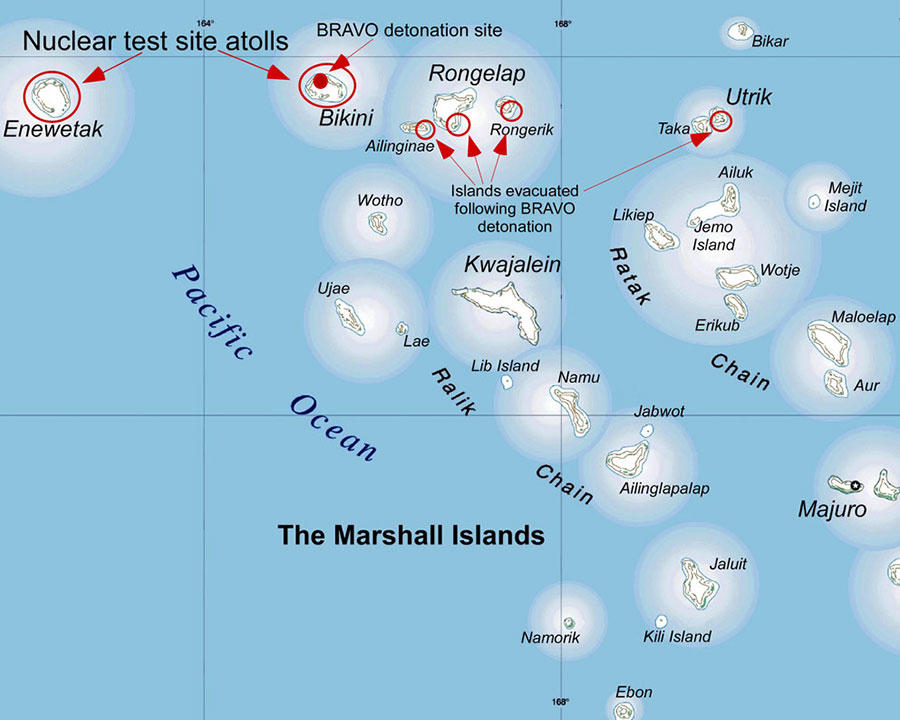Investigators in DCEG are conducting studies related to regions affected by radioactive fallout from nuclear weapons testing.
Trinity Nuclear Test, New Mexico
Investigators from DCEG and across the NCI estimated radiation doses from fallout in New Mexico following the July 1945 test by the U.S. government of the first atomic weapon. The test was code-named Trinity. DCEG investigators carried out in-depth interviews to ascertain the typical diet of populations living in New Mexico in the mid-1940s. These interviews were an important step in developing estimates of low, intermediate, radiation doses resulting from Trinity. To determine how best to collect these data, DCEG investigators engaged in discussions with academics with expertise in Native American and Hispanic lifestyles in the 1940s, as well as advocates and local community leaders. The study quantitatively estimated the number of cancer cases in New Mexico (past and future) that may be related to the nuclear test. Results were published in September 2020. Find more detailed information on Trinity, including a summary of the findings, and a link to the papers.
Nuclear Test, Republic of the Marshall Islands
DCEG investigators estimated radiation dose and risk from atmospheric nuclear weapons tests conducted in the Republic of the Marshall Islands from 1946 through 1958. This effort included a detailed assessment of all historical and contemporary measurements of environmental radiation on all atolls of the Marshall Islands as well as the use of a model of atmospheric dispersion and deposition. Results from these analyses were published in the August 2010 issue of Health Physics.
- Summary of the Marshall Islands research project and findings
- Bibliography of publications related to the Marshall Islands
Semipalatinsk Nuclear Test, Kazakhstan
DCEG investigators together with investigators from Kazakhstan and Russia are studying thyroid disease prevalence and radiation dose in a cohort of 2,994 subjects exposed at young ages to radioactive fallout from nuclear weapons testing during 1949-1962 at the Semipalatinsk Nuclear Test Site in northeastern Kazakhstan. Radiation exposure to the thyroid gland was from external radiation sources on the ground and other surfaces, and internally from radioactive iodine taken up by the thyroid gland following ingestion of milk from dairy animals grazing on contaminated pasture. Preliminary point estimates of individual external and internal dose averaged 0.04 Gy (range 0-0.65) and 0.31 Gy (0-9.6), respectively. Ultrasound-detected thyroid nodule prevalence, 18% among males and 39% among females was significantly and independently associated with both external and internal exposure. Results were published in 2015.
Thyroid Dose and Risk Calculator for Nuclear Weapons Fallout
Between 1945 and 1980, the U.S., the former Soviet Union, the U.K., France, and China, carried out more than 500 atmospheric tests of nuclear weapons totaling the explosive equivalent of 440 megatons of TNT. These tests emitted radioactive material into the atmosphere, much of which became widely dispersed before being deposited as fallout. DCEG investigators developed an online calculator to estimate the radiation dose received by the thyroid gland from radionuclides in fallout from nuclear tests. The early version of this tool estimated exposure and risk from fallout from the Nevada Test Site. In 2017, investigators released an update to the tool that includes exposures from sites outside of the United States (global fallout).
Dose Reconstruction and Health Consequences from Fallout
In collaboration with the Centers for Disease Control and Prevention, DCEG investigators estimated, for the first time, the radiation doses and risks of related health effects to representative persons in all counties of the contiguous United States from a set of important radionuclides produced from the testing of nuclear weapons from 1951 through 1962 by the United States and other nations. The findings of this feasibility study suggest that the health risks from exposure to fallout from past nuclear weapons tests may be small, but that it is technically feasible to conduct a detailed study of the health effects on the American people. The draft of this technical report was peer-reviewed by the National Academy of Sciences/National Research Council (NAS/NRC) Committee. To the extent possible, the Committee’s recommendations were taken into account in the final report. Read the Final Report: Public summary on radioactive fallout from global weapons testing.
